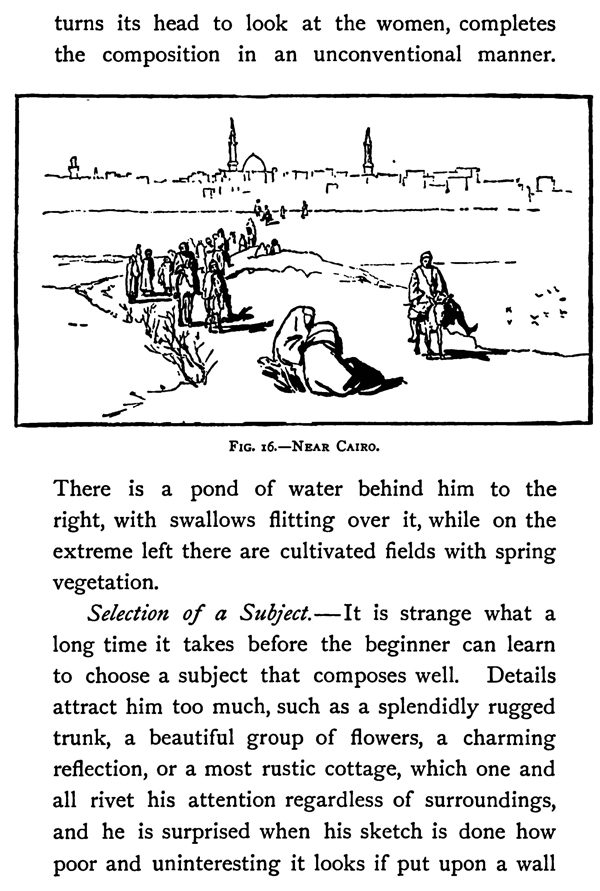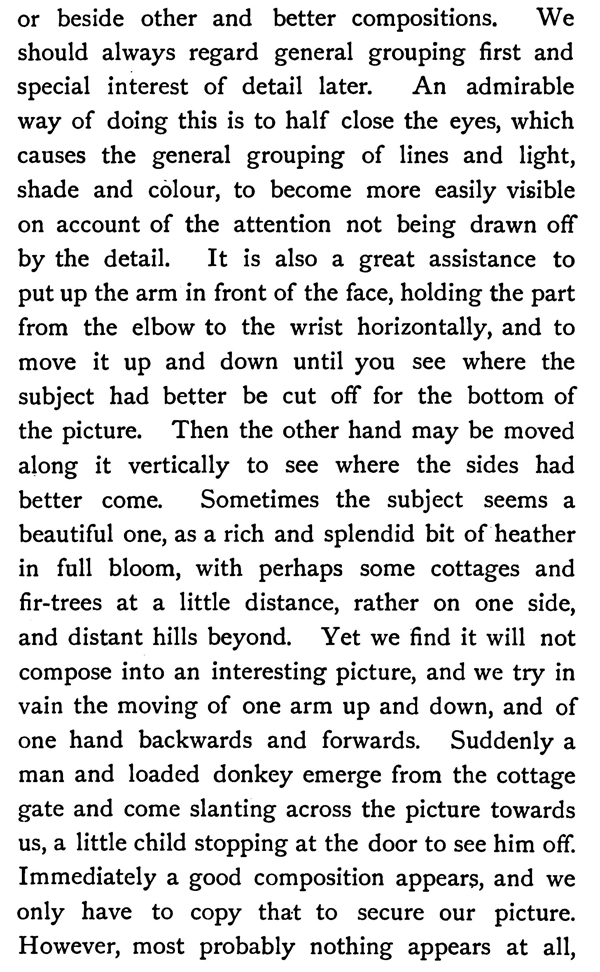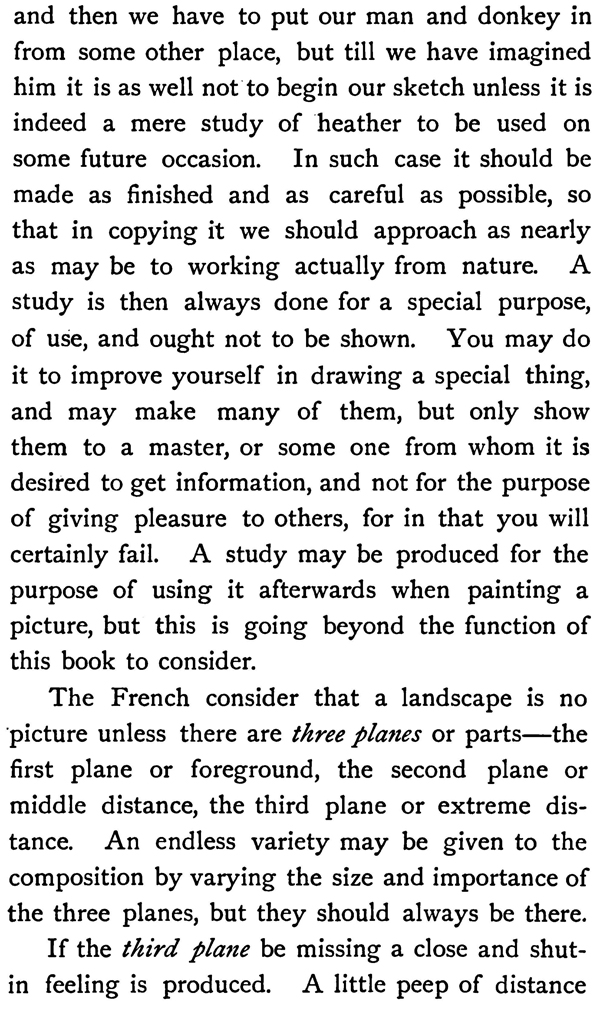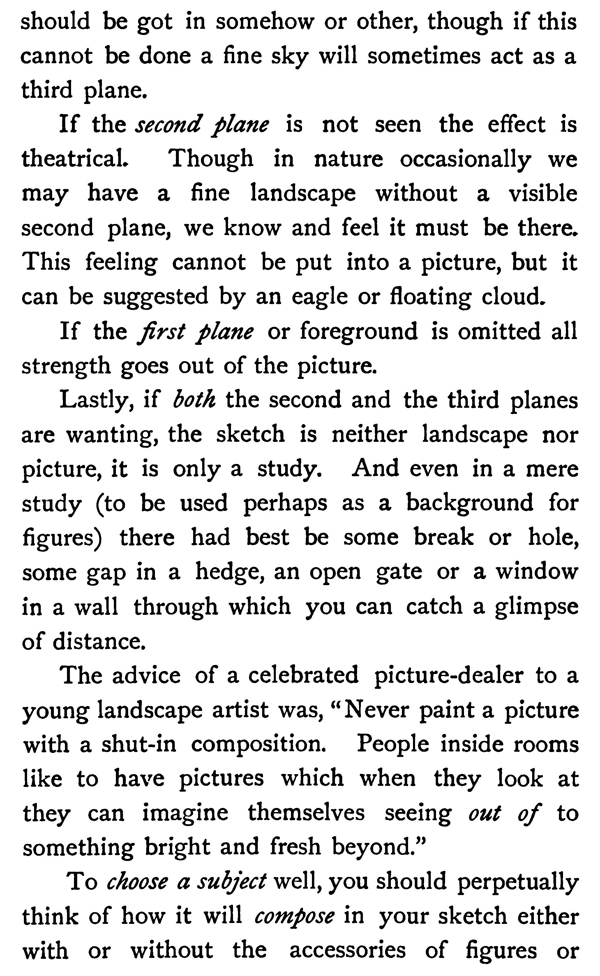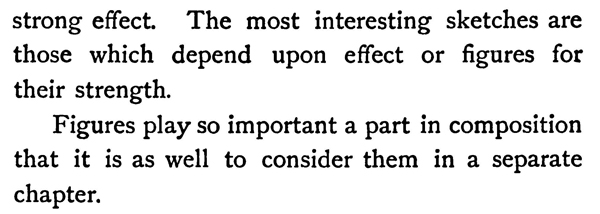Home > Directory Home > Drawing Lessons > Art Composition > Composition and Choosing Subjects for Your Drawings
Composition and Choosing the subjects of your drawings
|
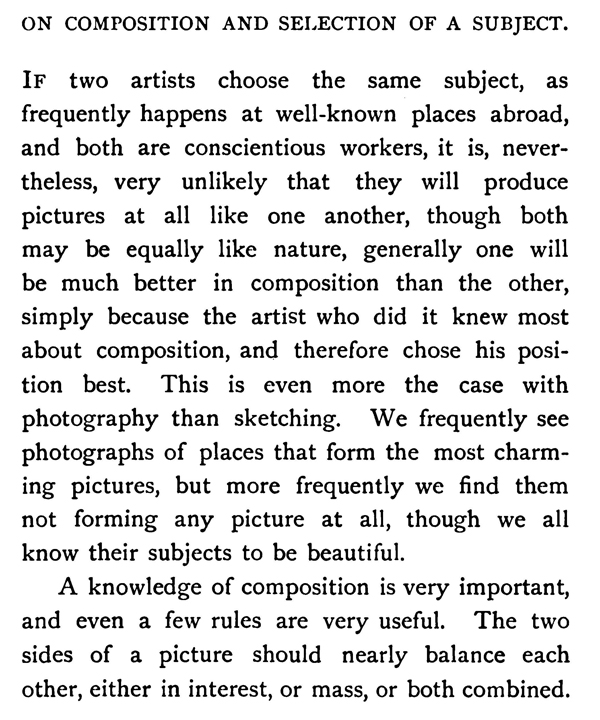
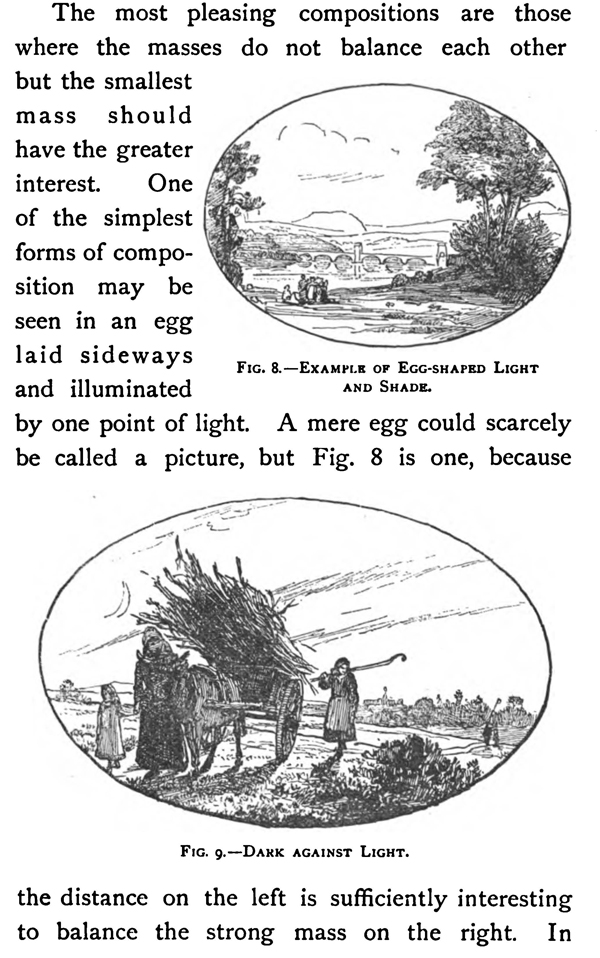
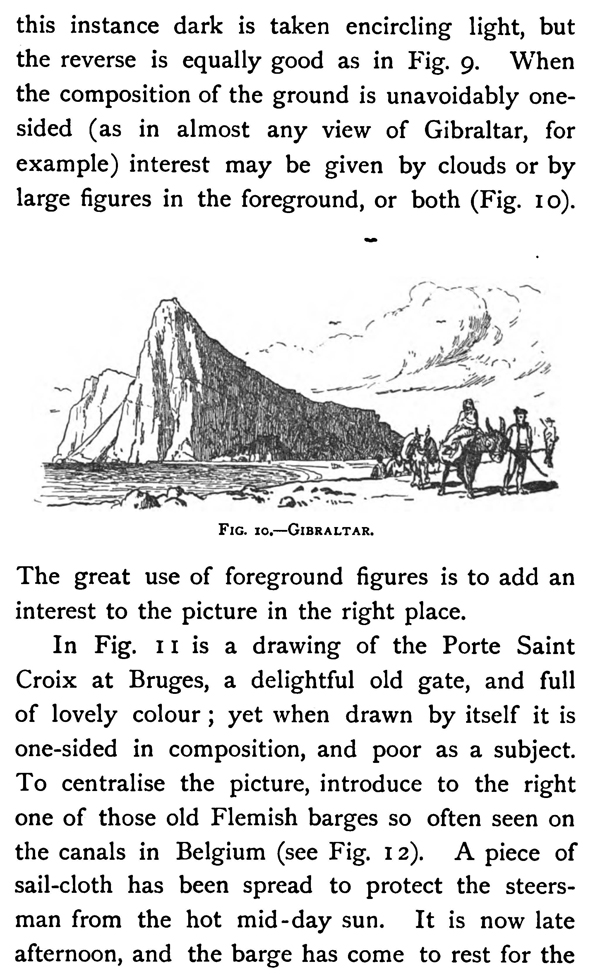
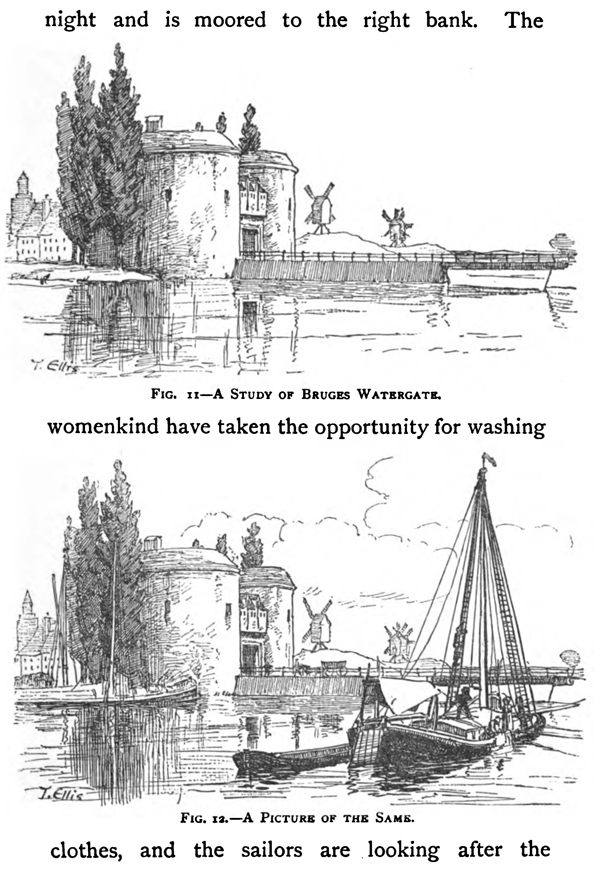
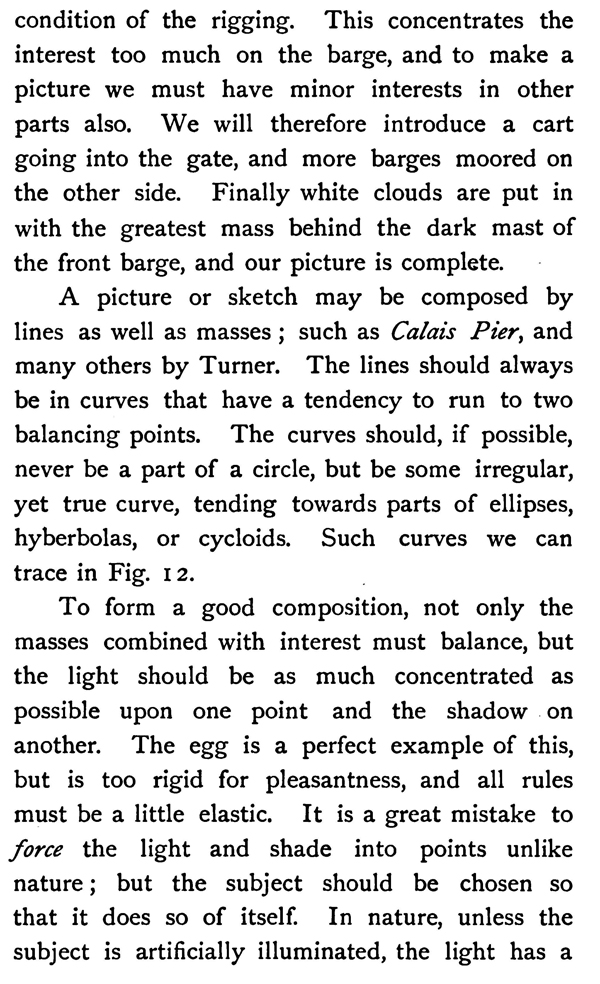
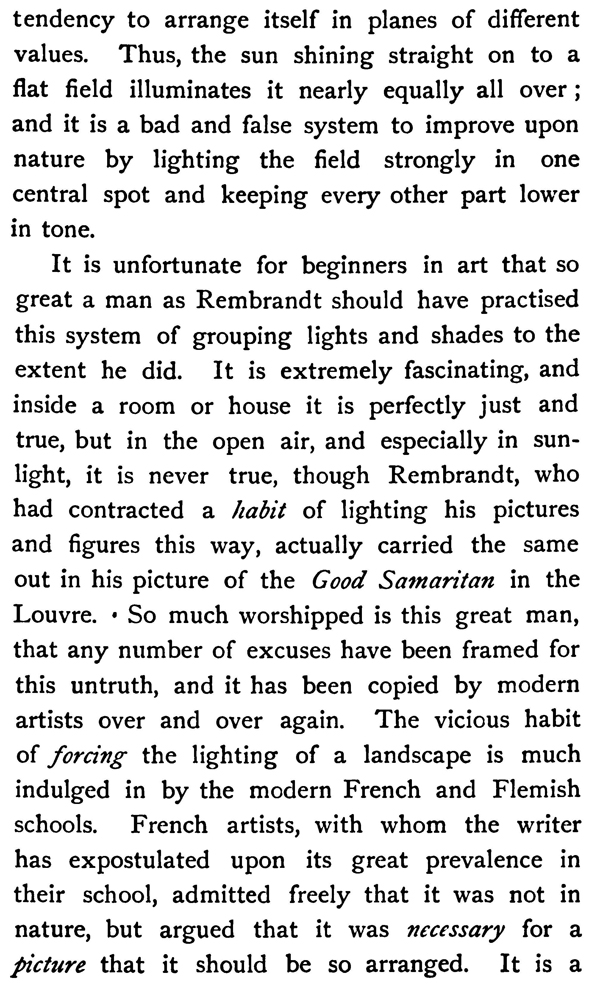
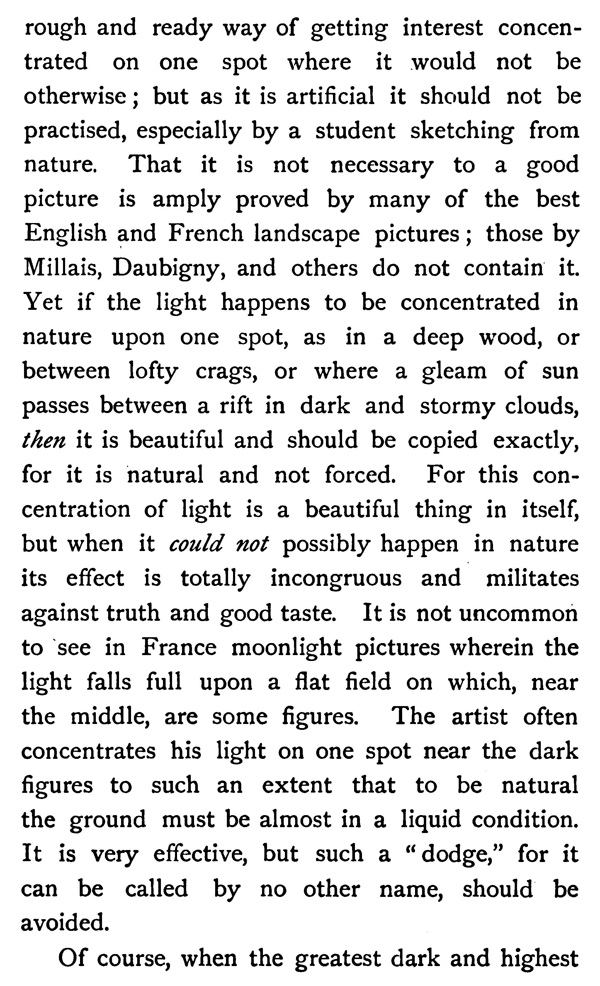
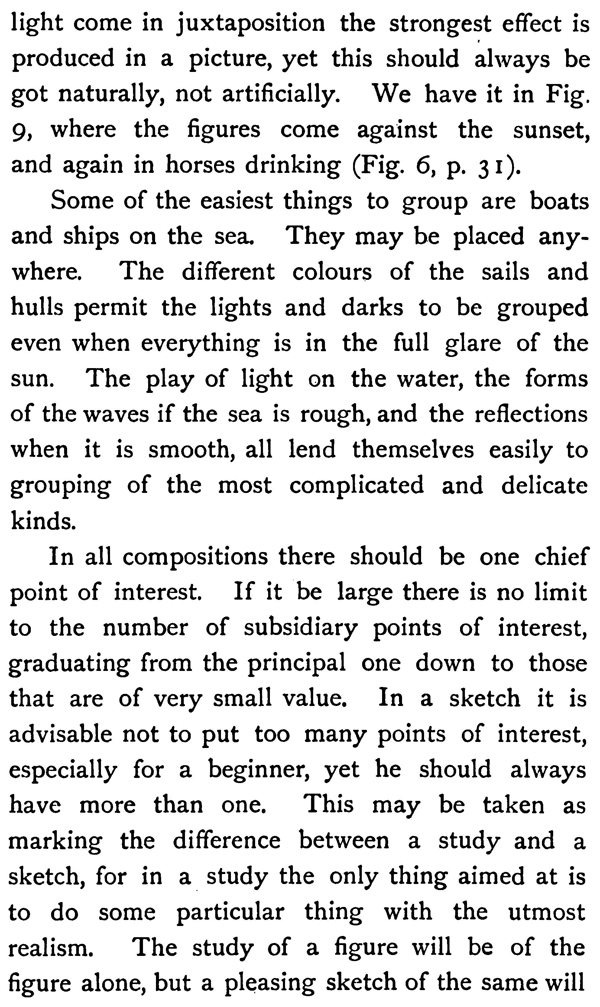

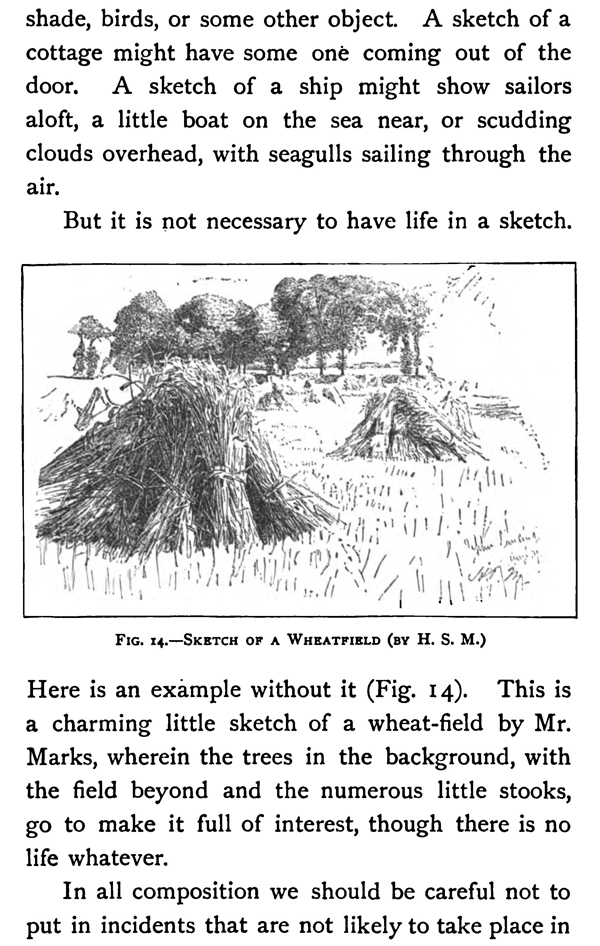
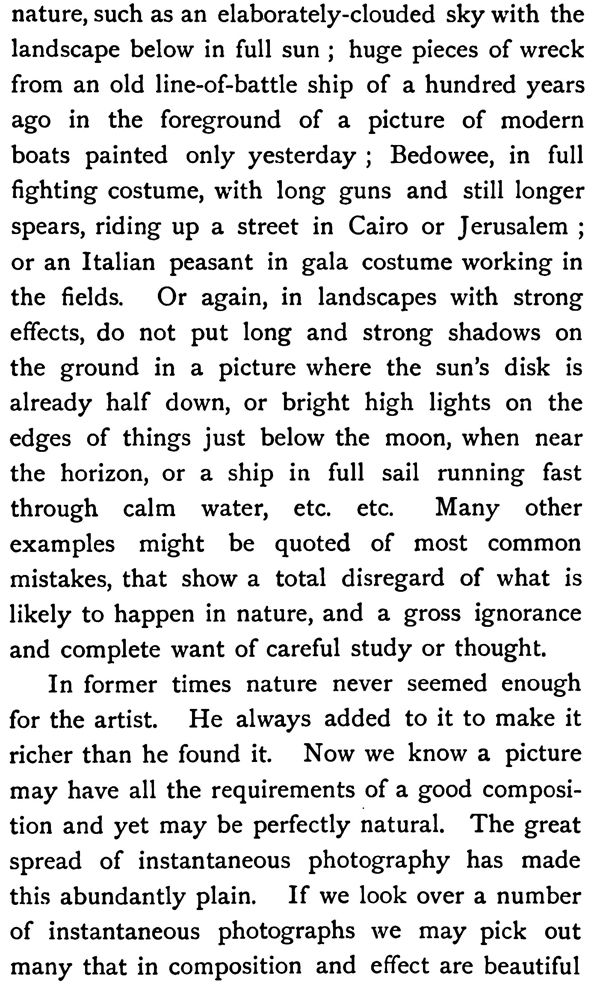
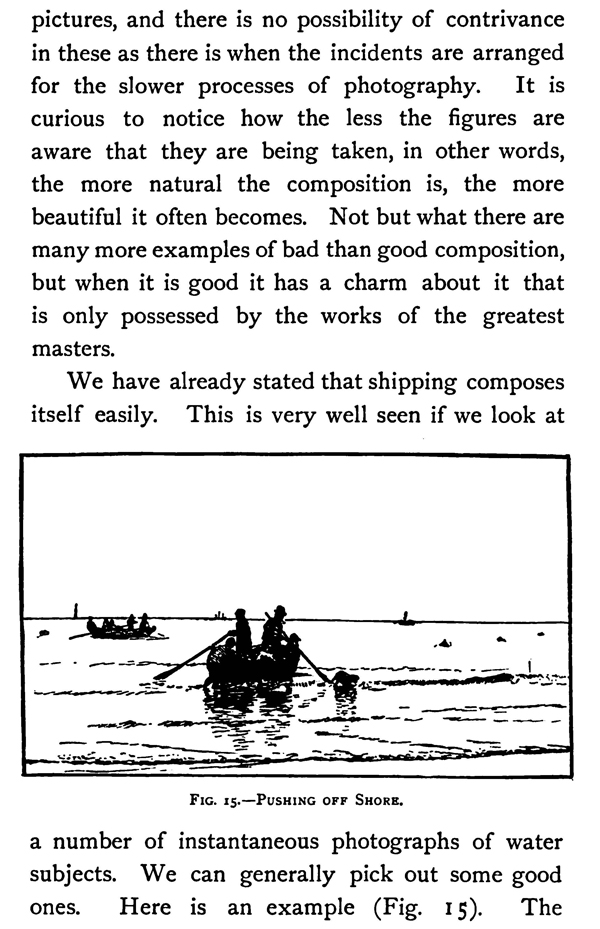
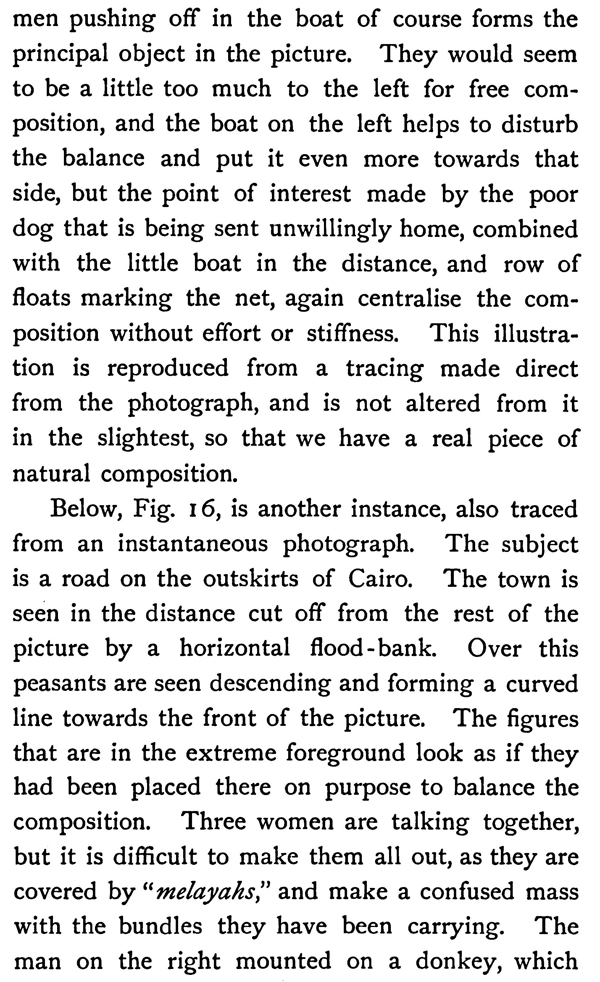
GO BACK TO THE HOME PAGE FOR TUTORIALS FOR BEGINNING ARTISTS
[The above words are pictures of text, below is the actual text if you need to copy a paragraph or two]
ON COMPOSITION AND SELECTION OF A SUBJECT.
IF two artists choose the same subject, as frequently happens at well-known places abroad, and both are conscientious workers, it is, nevertheless, very unlikely that they will produce pictures at all like one another, though both may be equally like nature, generally one will be much better in composition than the other, simply because the artist who did it knew most about composition, and therefore chose his position best. This is even more the case with photography than sketching. We frequently see photographs of places that form the most charming pictures, but more frequently we find them not forming any picture at all, though we all know their subjects to be beautiful.
A knowledge of composition is very important, and even a few rules are very useful. The two sides of a picture should nearly balance each other, either in interest, or mass, or both combined.
The most pleasing compositions are those where the masses do not balance each other but the smallest mass should have the greater interest. One of the simplest forms of composition may be seen in an egg laid sideways and illuminated by one point of light. A mere egg could scarcely be called a picture, but Fig. 8 is one, because the distance on the left is sufficiently interesting to balance the strong mass on the right. In this instance dark is taken encircling light, but the reverse is equally good as in Fig. 9. When the composition of the ground is unavoidably one-sided (as in almost any view of Gibraltar, for example) interest may be given by clouds or by large figures in the foreground, or both (Fig. 10).
The great use of foreground figures is to add an interest to the picture in the right place.
In Fig. 11 is a drawing of the Porte Saint Croix at Bruges, a delightful old gate, and full of lovely colour ; yet when drawn by itself it is one-sided in composition, and poor as a subject. To centralise the picture, introduce to the right one of those old
Flemish barges so often seen on the canals in Belgium (see Fig. 12). A piece of sail-cloth has been spread to protect the steersman from the hot mid-day sun. It is now late afternoon, and the barge has come to rest for the night and is moored to the right bank. The womenkind have taken the opportunity for washing clothes, and the sailors are looking after the condition of the rigging. This concentrates the interest too much on the barge, and to make a picture we must have minor interests in other parts also. We will therefore introduce a cart going into the gate, and more barges moored on the other side.
Finally white clouds are put in with the greatest mass behind the dark mast of the front barge, and our picture is complete.
A picture or sketch may be composed by lines as well as masses ; such as Calais Pier, and many others by Turner. The lines should always be in curves that have a tendency to run to two balancing points. The curves should, if possible, never be a part of a circle, but be some irregular, yet true curve, tending towards parts of ellipses, hyberbolas, or cycloids. Such curves we can trace in Fig. 12.
To form a good composition, not only the masses combined with interest must balance, but the light should be as much concentrated as possible upon one point and the shadow on another. The egg is a perfect example of this, but is too rigid for pleasantness, and all rules must be a little elastic. It is a great mistake to force the light and shade into points unlike nature ; but the subject should be chosen so that it does so of itself. In nature, unless the subject is artificially illuminated, the light has a tendency to arrange itself in planes of different values. Thus, the sun shining straight on to a flat field illuminates it nearly equally all over ; and it is a bad and false system to improve upon nature by lighting the field strongly in one central spot and keeping every other part lower in tone.
It is unfortunate for beginners in art that so great a man as Rembrandt should have practised this system of grouping lights and shades to the extent he did. It is extremely fascinating, and inside a room or house it is perfectly just and true, but in the open air, and especially in sunlight, it is never true, though Rembrandt, who had contracted a habit of lighting his pictures and figures this way, actually carried the same out in his picture of the Good Samaritan in the Louvre. • So much worshipped is this great man, that any number of excuses have been framed for this untruth, and it has been copied by modern artists over and over again. The vicious habit of forcing the lighting of a landscape is much indulged in by the modern French and Flemish schools.
French artists, with whom the writer has expostulated upon its great prevalence in their school, admitted freely that it was not in nature, but argued that it was necessary for a picture that it should be so arranged. It is a rough and ready way of getting interest concentrated on one spot where it would not be otherwise ; but as it is artificial it should not be practised, especially by a student sketching from nature. That it is not necessary to a good picture is amply proved by many of the best English and French landscape pictures ; those by Millais, Daubigny, and others do not contain it. Yet if the light happens to be concentrated in nature upon one spot, as in a deep wood, or between lofty crags, or where a gleam of sun passes between a rift in dark and stormy clouds, then it is beautiful and should be copied exactly, for it is natural and not forced. For this concentration of light is a beautiful thing in itself, but when it could not possibly happen in nature its effect is totally incongruous and militates against truth and good taste. It is not uncommon to see in France moonlight pictures wherein the light falls full upon a flat field on which, near the middle, are some figures. The artist often concentrates his light on one spot near the dark figures to such an extent that to be natural the ground must be almost in a liquid condition. It is very effective, but such a " dodge," for it can be called by no other name, should be avoided.
Of course, when the greatest dark and highest light come in juxtaposition the strongest effect is produced in a picture, yet this should always be got naturally, not artificially. We have it in Fig. 9, where the figures come against the sunset, and again in horses drinking (Fig. 6).
Some of the easiest things to group are boats and ships on the sea. They may be placed anywhere. The different colours of the sails and hulls permit the lights and darks to be grouped even when everything is in the full glare of the sun. The play of light on the water, the forms of the waves if the sea is rough, and the reflections when it is smooth, all lend themselves easily to grouping of the most complicated and delicate kinds.
In all compositions there should be one chief point of interest. If it be large there is no limit to the number of subsidiary points of interest, graduating from the principal one down to those that are of very small value. In a sketch it is advisable not to put too many points of interest, especially for a beginner, yet he should always have more than one. This may be taken as marking the difference between a study and a sketch, for in a study the only thing aimed at is to do some particular thing with the utmost realism. The study of a figure will be of the figure alone, but a pleasing sketch of the same will introduce some characteristic feature of interest in the background or foreground. For example (Fig. 13), here is a man asleep, who by himself would be sufficiently uninteresting, but by the addition of surroundings a most charming and interesting sketch is made. We learn that as there is no wind he has fallen asleep at the tiller, from having nothing to do. The near sail hangs idly, a small boat is drawn up on the beach, and there is not a person moving. A delightful little incident, carrying out the calm of the picture, is the motionless windmill at the top of the slight rise in the distance.
A sketch of a tree would have some other trees lightly indicated behind, some sheep in the shade, birds, or some other object. A sketch of a cottage might have some one coming out of the door. A sketch of a ship might show sailors aloft, a little boat on the sea near, or scudding clouds overhead, with seagulls sailing through the air.
But it is not necessary to have life in a sketch.
Here is an example without it (Fig. 14). This is a charming little sketch of a wheat-field by Mr. Marks, wherein the trees in the background, with the field beyond and the numerous little stooks, go to make it full of interest, though there is no life whatever.
In all composition we should be careful not to put in incidents that are not likely to take place in nature, such as an elaborately-clouded sky with the landscape below in full sun ; huge pieces of wreck from an old line-of-battle ship of a hundred years ago in the foreground of a picture of modern boats painted only yesterday ; Bedowee, in full fighting costume, with long guns and still longer spears, riding up a street in Cairo or Jerusalem ; or an Italian peasant in gala costume working in the fields. Or again, in landscapes with strong effects, do not put long and strong shadows on the ground in a picture where the sun's disk is already half down, or bright high lights on the edges of things just below the moon, when near the horizon, or a ship in full sail running fast through calm water, etc. etc. Many other examples might be quoted of most common mistakes, that show a total disregard of what is likely to happen in nature, and a gross ignorance and complete want of careful study or thought.
In former times nature never seemed enough for the artist. He always added to it to make it richer than he found it. Now we know a picture may have all the requirements of a good composition and yet may be perfectly natural. The great spread of instantaneous photography has made this abundantly plain. If we look over a number of instantaneous photographs we may pick out many that in composition and effect are beautiful pictures, and there is no possibility of contrivance in these as there is when the incidents are arranged for the slower processes of photography. It is curious to notice how the less the figures are aware that they are being taken, in other words, the more natural the composition is, the more beautiful it often becomes. Not but what there are many more examples of bad than good composition, but when it is good it has a charm about it that is only possessed by the works of the greatest masters.
We have already stated that shipping composes itself easily. This is very well seen if we look at a number of instantaneous photographs of water subjects. We can generally pick out some good ones.
Here is an example (Fig. 15). The men pushing off in the boat of course forms the principal object in the picture. They would seem to be a little too much to the left for free composition, and the boat on the left helps to disturb the balance and put it even more towards that side, but the point of interest made by the poor dog that is being sent unwillingly home, combined with the little boat in the distance, and row of floats marking the net, again centralise the composition without effort or stiffness.
This illustration is reproduced from a tracing made direct from the photograph, and is not altered from it in the slightest, so that we have a real piece of natural composition.
Below, Fig. 16, is another instance, also traced from an instantaneous photograph. The subject is a road on the outskirts of Cairo. The town is seen in the distance cut off from the rest of the picture by a horizontal flood-bank. Over this peasants are seen descending and forming a curved line towards the front of the picture. The figures that are in the extreme foreground look as if they had been placed there on purpose to balance the composition. Three women are talking together, but it is difficult to make them all out, as they are covered by "melayahs," and make a confused mass with the bundles they have been carrying. The man on the right mounted on a donkey, which turns its head to look at the women, completes the composition in an unconventional manner.
There is a pond of water behind him to the right, with swallows flitting over it, while on the extreme left there are cultivated fields with spring vegetation.
Selection of a Subject—It is strange what a long time it takes before the beginner can learn to choose a subject that composes well. Details attract him too much, such as a splendidly rugged trunk, a beautiful group of flowers, a charming reflection, or a most rustic cottage, which one and all rivet his attention regardless of surroundings, and he is surprised when his sketch is done how poor and uninteresting it looks if put upon a wall or beside other and better compositions. We should always regard general grouping first and special interest of detail later. An admirable way of doing this is to half close the eyes, which causes the general grouping of lines and light, shade and colour, to become more easily visible on account of the attention not being drawn off by the detail. It is also a great assistance to put up the arm in front of the face, holding the part from the elbow to the wrist horizontally, and to move it up and down until you see where the subject had better be cut off for the bottom of the picture. Then the other hand may be moved along it vertically to see where the sides had better come. Sometimes the subject seems a beautiful one, as a rich and splendid bit of heather in full bloom, with perhaps some cottages and fir-trees at a little distance, rather on one side, and distant hills beyond. Yet we find it will not compose into an interesting picture, and we try in vain the moving of one arm up and down, and of one hand backwards and forwards. Suddenly a man and loaded donkey emerge from the cottage gate and come slanting across the picture towards us, a little child stopping at the door to see him off.
Immediately a good composition appears, and we only have to copy that to secure our picture. However, most probably nothing appears at all, and then we have to put our man and donkey in from some other place, but till we have imagined him it is as well not to begin our sketch unless it is indeed a mere study of heather to be used on some future occasion. In such case it should be made as finished and as careful as possible, so that in copying it we should approach as nearly as may be to working actually from nature. A study is then always done for a special purpose, of use, and ought not to be shown. You may do it to improve yourself in drawing a special thing, and may make many of them, but only show them to a master, or some one from whom it is desired to get information, and not for the purpose of giving pleasure to others, for in that you will certainly fail. A study may be produced for the purpose of using it afterwards when painting a picture, but this is going beyond the function of this book to consider.
The French consider that a landscape is no picture unless there are three planes or parts—the first plane or foreground, the second plane or middle distance, the third plane or extreme distance. An endless variety may be given to the composition by varying the size and importance of the three planes, but they should always be there.
If the third plane be missing a close and shutin feeling is produced. A little peep of distance should be got in somehow or other, though if this cannot be done a fine sky will sometimes act as a third plane.
If the second plane is not seen the effect is theatrical. Though in nature occasionally we may have a fine landscape without a visible second plane, we know and feel it must be there. This feeling cannot be put into a picture, but it can be suggested by an eagle or floating cloud.
If the first plane or foreground is omitted all strength goes out of the picture.
Lastly, if both the second and the third planes are wanting, the sketch is neither landscape nor picture, it is only a study. And even in a mere study (to be used perhaps as a background for figures) there had best be some break or hole, some gap in a hedge, an open gate or a window in a wall through which you can catch a glimpse of distance.
The advice of a celebrated picture-dealer to a young landscape artist was, "Never paint a picture with a shut-in composition.
People inside rooms like to have pictures which when they look at they can imagine themselves seeing out of to something bright and fresh beyond."
To choose a subject well, you should perpetually think of how it will compose in your sketch either with or without the accessories of figures or strong effect. The most interesting sketches are those which depend upon effect or figures for their strength.
Privacy Policy ..... Contact Us





